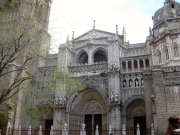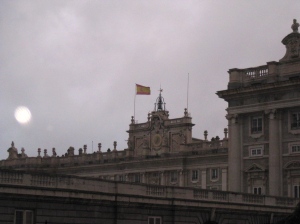The original Chinese text follows my translation. I’m sure there will be other records of the article even if it does end up getting wiped from every Chinese site, but it doesn’t hurt to keep an extra copy here and there. Thanks to Lu Meichen for cultural info. Massive thanks to Linch Zhang for help translating and preserving linguistic quirks! If any other Chinese speakers or former classmates see more language issues, please let me know.
We’re All Waiting for the First People to Die in Beijing
Li Shanglong
Ten years ago, I heard that a distant relative of mine had gotten cancer, and I asked my father, “What’s cancer?” My father said that cancer is a kind of terminal illness, and there’s no cure–you just wait to die. And then he said, more happily, that there fortunately weren’t many people in our country who got cancer.
Back then, he was right. But these days, who can say they don’t have several close friends and relatives with cancer?
Today, Beijing is once again covered in smog. It used to be that you couldn’t see Mao’s portrait if you stood in front of Tiananmen Square.1 Nowadays, you can’t see Mao if you hold a ¥100 note in front of your very eyes.2 I originally thought that only Beijing was this bad, but I slowly came to realize that our neighboring cities were more or less just as polluted. In Beijing, we wait every day for the wind to come and blow the pollution away so it can hang in other cities. But for the past two days there has been no wind. The odd-even license plate policy is in place.3 Yesterday everyone jeered at it: if you limit our even-numbered cars and the pollution is just as bad as it was before–well, that just shows what a problem we must have with our odd-numbered cars! Today it’s the odd-numbered drivers turn to complain. Once everything else has been limited, they’ll start restricting flatulence.
I don’t dare to imagine my children growing up in this kind of environment. It’s said that Beijing’s children’s hospitals are already bursting with children who can’t stop coughing and adults who can’t stop crying. I’m not even a little surprised. I’ve been in Beijing since 2008, and I cough practically every morning, sometimes to the point of tears. But why haven’t I complained? It’s very simple: look at what happened to Chai Jing.4 Once upon a time she wrote Insight, and now she’s completely out of sight.
Jack Ma5 has said that he actually really likes smog and haze, because the privileged elite get their own specially provided food, their own special milk and water, but they can’t get their own special air.
Even though that’s true, I’m still curious: since they can’t breathe their own special air, why is the pollution getting worse with every new attempt to regulate it? Many of the large factories around Hebei province have already closed, many employees did not collect a salary even before they were barred from working, we’ve limited the time we can drive our cars–but the pollution is as bad as before, so bad that you can’t see all five fingers on your outstretched hand.
People on the street are gradually becoming numb. Before, everyone would rush to buy PM 2.5 masks, but now you can see that people from all walks of life have stopped wearing them. People riding bicycles look all around, expressionless, and our kuai di6 brothers keep dashing around, hard at work, on their motorcycles. Our food delivery brothers on their electric bikes take big lungfuls of air. In a city this big, there seem to be only two ways to manage smog: wait for the wind to blow, or just rely on ten million people working hard to breathe it in.
Fortunately we’re still in a state-mandated vacation, and on break people can go out of town,7 change their filters, and keep breathing. Suggesting an activity like, “Run away from Beijing, Shanghai, and Guangzhou,” is like everybody actually being able to run away, leave for a few days, and then obediently come back.
In America, if you want to make a car you go to Detroit, if you want to make a movie you go to Los Angeles. In China, sorry, to do anything you have to go to Beijing, Shanghai, or Guangzhou, otherwise you won’t have an opportunity to better yourself. All your friends will come Beijing, and they’ll helplessly say with us, “Well, we have to breathe this pollution, better breathe it and get healthy!”
Now, it’s hard to leave to leave Beijing even if you want to. Because of the pollution, there are huge delays at the airport; if you want to take a train, it’s almost impossible to buy a ticket because Chinese New Year is coming up. Since you can’t run away, you can only learn from Professor Dan8 and try not to breathe in the smog: try your hardest not to go outside, you can’t win against that air. Try your hardest not to let smog enter your house, use air filters. Try your hardest not to let the smog into your lungs. And if none of this helps, then you can only rely on your good spirits for protection, and try your hardest not to let the smog into your heart.
But once you’re facing the attack of a disease, once a terminal illness looms near, we all have no way to breathe, our bodies can’t exist, and the triumph of the spirit has as much use as flatulence.
Now that I’ve written this far, I feel awful. I originally wanted to take a break. But when I look at this dim Beijing, I cannot stop myself writing a couple sentences. I know there are people saying, “Come on, Shanglong, you don’t have to keep writing about this. You should rest. Everyone sees the pollution, and you keep on talking about it. Are you sick?”9
Yes, I am sick. These past two mornings I’ve been unable to stop coughing, and now that I think about it, I’ll get sick sooner or later. The people in this city are all already sick. More of us are getting sicker. What does it matter if a writer announces prematurely that he’s sick?
I keep thinking: why has everyone been so silent, even today? It’s simple, it’s because the pollution still hasn’t directly led to a death. To speak plainly, we’re all waiting for the pollution to make its first ghosts. We are all just expecting not to be the first ones to go. But once these deaths have been blown up in the media, once these cases have been pushed in front of our noses, we’ll discover that we ourselves may not have anything to say, or may not be able to say what we want.
In 2014 the mayor of Beijing said, “Let us lift our heads and look at whether we handle pollution well in 2017.” People complained online about the pollution and asked, can we really live till then? The good part is, we survived till now. The bad part is, we remember, we’ve lifted our heads and looked, and we cannot see. The scary part is, that at this time, this moment we are just trying our hardest not to breathe.
We used to think that good fortune was money, a good name, and a good position. Now we just wish for wind.
Remember the blue sky.
1 Mao’s portrait hangs over the main entrance to Tiananmen Square. It’s one of the most iconic images of modern China and I 100% forgot about it when I first translated this piece.
2 Mao is on all Chinese paper currency worth ¥1 or more.
3 Policy allowing only cars with certain license plate numbers to drive on certain days, in order to reduce traffic and pollution.
4 Chai Jing (柴静) is a treasure, an extraordinary activist who risked (and basically lost) her career as a news anchor to make Under the Dome (穹顶之下), an investigative documentary about pollution in China. Her autobiography was called Insight.
5Jack Ma (马云) is the chairman of Alibaba Group, and he is not messing around. In 2010 Alibaba started earmarking 0.3% of annual revenue to environmental work, mostly water and air quality projects. He hopes people will remember him as a Tai Chi master rather than the Alibaba guy, which, well, good luck.
6 快递 Kuai di delivery guys are out all day. They’re often stuck behind some horrible old truck from the 1970s that belches death fumes right into their faces.
7 In China, 外地/wai di (outside place) means basically anywhere that isn’t Beijing, Shanghai, or Guangzhou. “Out of town” is practically the entire country.
8 Professor Dan (丹老师) is a famous Weibo (China’s answer to Twitter) personality.
9 “Are you sick?” is equivalent to “What’s the matter with you?” or “What are you doing?”




































